There are a number of jungle destinations/ports of entry in Peru, but the largest and most popular is Iquitos, a 1 hour 40 minute flight from Lima.
Peru is a country of mind-boggling bio-diversity. Where I live in the Sacred Valley (at 3,300 meters/ 11,000 feet above sea level), the air is dry, the temperatures cool (especially at night), and the scenery mountainous.
Head towards the coast and you’ll find much warmer weather, ranging from the muggy haze of Lima to desert dunes (with South America’s only proper desert, and sister to the Sahara).
Between these two extremes you’ll find everything in between, including the jungle – and lots of it.
25% of visitors to Iquitos are there to explore work with ayahuasca in various jungle retreat centres up the river or down the road from Iquitos, which is also precisely why I found myself landing in Iquitos as well. (More on that later in this series).
This post was originally published in 2015. It has since been updated for accuracy of links and content.
Americas or Asias?
In stark contrast to the tranquility of the jungle, Iquitos is a madhouse. Initially it reminded me more of Southeast Asia than of South America. I felt an Asian deja vu with the warm muggy air, the dusty streets, and the simple architecture. But what most reminded me of Asia was the moto traffic.
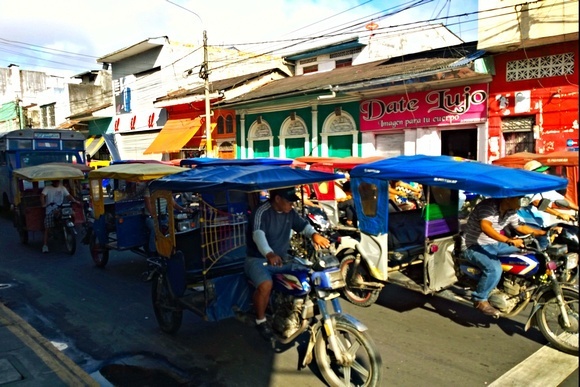
Scooters, motorcycles, and most commonly, rickshaws (or “motos” as they’re referred to), rule the roads in Iquitos. It’s a cacophony of movement and noise that is simultaneously chaotic and harmonious. Road lanes are considered guidelines rather than rules, as vehicles large and small all jostle for position at every intersection, filling in all available space.
Belen Market

You can escape the traffic – but certainly not the chaos – in Belen market. Covering a few city blocks of muddy alleyways open to pedestrians only, you’ll find tightly-knit stalls selling everything from fresh fish and meat, to fruits and vegetables, to prepared foods, odds and ends, and more.
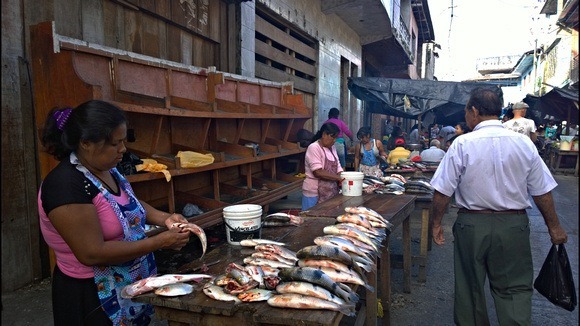
Of curious interest was “medicine alley”, where local potions and remedies, voodoo-looking objects, supplements, powders, incenses, and more are for sale.
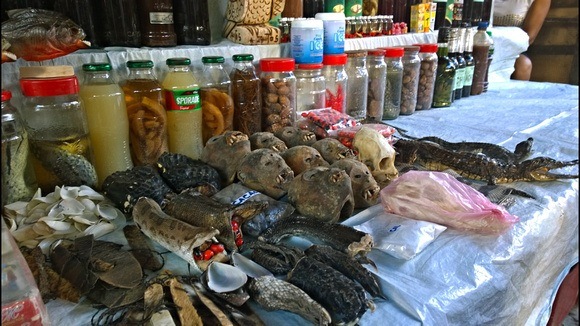
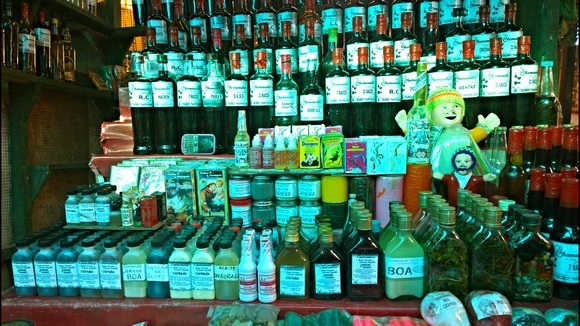
Just below Belen market, literally on (and sometimes in) the Amazon river is the neighbourhood of Belen itself. Houses here are built on stilts and are often two stories high, but in the rainy season the first story is underwater. (I didn’t venture into Belen proper, as I didn’t have time, and was also warned that it’s not particularly safe for foreigners as there are frequent robberies).
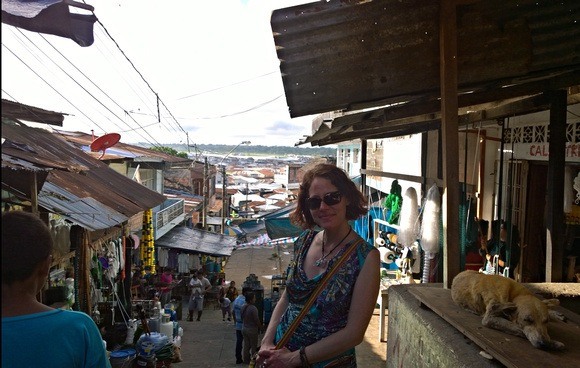
The Amazon
Iquitos is situated on the banks of the mighty Amazon river; I found myself quite moved to finally see this famed river with my own eyes, and I wasn’t disappointed either. It’s gorgeous. (I mean, the Amazon even has pink dolphins in it. Pink. Dolphins. If that doesn’t make it magical, nothing does).

A short walk from the main plaza of Iquitos, the area by the river is closed to traffic; so not only will you find beautiful views, but also the quietest most peaceful part of Iquitos to escape the fray.
In and Out of Iquitos
I only had a couple of days in total in Iquitos (as is the case for many tourists), as it was simply my port of entry/exit to spending a month in the jungle.
Iquitos doesn’t call to me to return and spend large amounts of time there in and of itself, but it’s likely a place I’ll see again the next time I’m jungle-bound. And for that, I’m happy.
Stay tuned for more on my month in the jungle of Peru, including daily life and and recommendations, critter encounters, what it’s like to experience an ayahuasca diet, and excerpts from my jungle-journal.

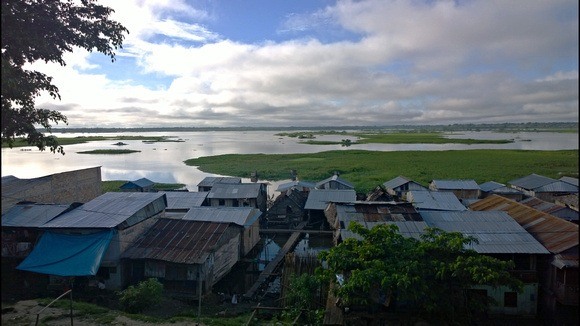

Wow! You journey is very inspiring. I can’t wait to hear about your days with the Shaman. I remember reading: The Teachings of Don Juan: A Yaqui Way of Knowledge, when I was younger. It certainly put the world and how we perceive it in a different light. Do you find it easy to process what you come across in your study with the Shaman that is way outside your usual way of thinking? And is there an added dimension to you perceptions of reality now?
Hi Judith,
Great questions! Yes, I’ve shifted my way of thinking quite dramatically over the last year and a half of working with plant medicines. And one thing I’ve learned is that in becoming a shaman, it’s about developing my own relationship with the medicine – through drinking it and doing ceremonies. For that, my time in the jungle was amazing.
And indeed, there is a totally different dimension to my perceptions of reality.
When I visited my family and friends in Canada last year after 2 months of doing ceremonies, they all remarked on how different I am – how much more relaxed and happy I seemed, and how I didn’t get bothered or stressed by things that previously would have sent me climbing the walls.
So it’s certainly made a positive difference in my life!
I’ve spent about a month near Iquitos myself doing something similar to what you’re doing. Really looking forward to reading more about your experience and impressions. Iquitos felt like the wild west to me – strange energy about that place.
Hi Laura,
Your diagnosis of the “wild west” feeling in Iquitos is spot on. And I think it dates back a few hundred years when Iquitos was the hub of rubber production around the world (which put Iquitos on the map), and really was a “wild west” for Europeans settling there to make rubber.
Today, there’s one of everybody living in Iquitos, and rumour has it that it’s also a bit of a CIA hub.
I certainly agree with your diagnosis – it has a strange energy!
It looks fascinating especially medicine alley, okay maybe a little bit freaky that bit.
Shame Belen itself is classified as unsafe, based on where you were stood it looks highly accessible for people to accidentally venture into.
Hi Guy,
I don’t know if Belen is ridiculously dangerous or just a little bit unsafe. But even to find this access route into Belen isn’t as easy as you might think; it’s kind of buried at one end of the market.
Like all travels, I think it’s just a matter of having good street sense. Also, there really is no reason for a tourist to walk through that neighbourhood, other than to see “how the other side lives”, which is a bit unsavoury for me to do anyway.
Wow .. .Iquitos does have an Asian vibe to it … too bad it is not as safe as many parts of Asia…
Hi Tina,
I didn’t necessarily find Iquitos to be dangerous – no more dangerous than the places I’ve visited in Asia – especially if you find yourself in the wrong neighbourhood. But in Iquitos, like many places (including Asia), a good dose of street sense is required, especially as a foreigner.
I read this article when it came out, and just wanted to let you know how much I enjoyed it. Since I know I will only be able to visit a fraction of all the interesting place in the world, I’m so glad to be able to experience some of the rest through first-rate writers like you who make us feel like we’ve been there just reading the article!
Bob
Aw…..thanks, Bob! Glad you’ve enjoyed reading my posts and doing a bit of armchair travelling during your trip!
Read the whole series, loved it! loved reading about the termites and the cool “room” and the adventures it caused. What a great adventure. Love your blog!
Thank you so much, Rebecca! I’m headed back to the jungle in May 2016 – and looking forward to another adventure.